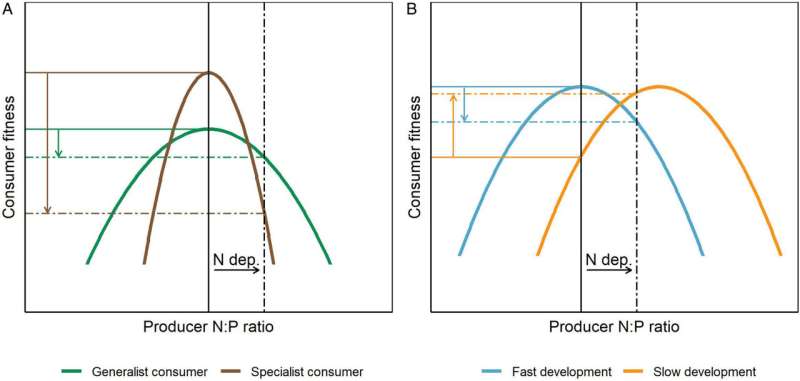This article has been reviewed according to Science X's editorial process and policies. Editors have highlighted the following attributes while ensuring the content's credibility:
fact-checked
peer-reviewed publication
trusted source
proofread
Effect of nitrogen deposition on animal species stronger than expected

Anthropogenic increased nitrogen deposition is a well-known environmental stressor, resulting in impoverishment of soil quality in naturally nutrient-poor ecosystems. As a result, habitat conditions for plant and animal species are also changing. Such changes are sometimes clearly visible in the field. For instance, plant species that benefit from extra nitrogen often become dominant, leading to grass-dominance in heathlands and increasing cover of blueberries and bramble in woodlands. Less visible however are the effects of nitrogen deposition on food quality of plants, and the subsequent effects on animal fitness.
A group of researchers from several Dutch and Belgian universities and research institutes show that nitrogen deposition alters the ratio of nutrients in plants, which in turn may lead to a reduced performance in many animal species. The findings were recently published in the journal Biological Reviews.
The ratio of nitrogen with other important elements such as phosphorus and calcium shifts, and plants often produce more nitrogen-rich amino acids relative to other essential amino acids under increased nitrogen load. As a result, shortages of necessary nutrients for animals can occur more often. Plants also invest less in carbon-rich defense chemicals, while nitrogen-rich toxins increase.
Animal species that grow rapidly and insects that perform a complete metamorphosis, from larva to adult via a pupal stage, such as butterflies, bees and flies, require relatively high levels of phosphorus in order to sustain this high growth speed. These species are thus more affected by changes in plant quality than slow-growing species and insects that develop as nymphs, such as bugs and grasshoppers.
By comparing these and other traits of species, the researchers concluded that a small group of generalist species likely benefits from the extra nitrogen and pest outbreaks will occur more often, but a much larger group of animal species suffers from changed nutrient content and thus will decline or disappear under increased nitrogen load.
More information: Joost J. Vogels et al, Towards a mechanistic understanding of the impacts of nitrogen deposition on producer–consumer interactions, Biological Reviews (2023). DOI: 10.1111/brv.12972
Journal information: Biological Reviews
Provided by Radboud University


















